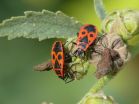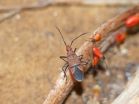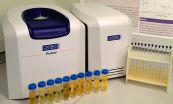The nutritionists within
Firebugs depend on gut bacteria for vitamin supply
2014-12-01
(Press-News.org) This news release is available in German.
Microbial partners are important for the nutrition of many insects. They help detoxify and digest food, but also provide essential nutrients that insects need in order to survive. The European firebug Pyrrhocoris apterus and the African cotton stainer Dysdercus fasciatus feed mainly on plant seeds that are poor sources of essential B vitamins. Scientists of the Max Planck Research Group Insect Symbiosis at the Max Planck Institute for Chemical Ecology in Jena, Germany, together with colleagues at the Friedrich Schiller University, have now found that bacterial symbionts in the insects' gut produce these vitamins and thereby ensure the host's metabolic stability and, ultimately, survival. Interestingly, the vitamin supply provided by the symbionts directly influences the gene regulation of their host: If the bacterial associates are absent, the bugs show a characteristic vitamin deficiency response. However, the symbiosis between the bugs and their bacteria is not necessarily a harmonious one: The insects are proposed to actively harvest the vitamins from the bacteria by using specific enzymes that burst open the bacterial cell walls. (Proceedings of the Royal Society B: Biological Sciences, November 2014).
In their quest for a balanced meal plan, firebugs - and many other animals - depend on dietary supplements. Firebugs are a group of terrestrial insects that includes the ubiquitously found European firebug Pyrrhocoris apterus as well as the agricultural pest, the African cotton stainer Dysdercus fasciatus. As demonstrated previously, firebugs depend on their gut microbes for successful development. The symbiotic bacteria from the Coriobacteriaceae family provide essential vitamins. Microbe-free bugs suffer high mortality and produce fewer young than bugs that have their microbial partners (see our press release "Bugs need symbiotic bacteria to exploit plant seeds" - http://www.ice.mpg.de/ext/976.html, January 9, 2013).
Controlled experiments by the scientists from Jena implicate the bacterial symbionts in supplementing B vitamins to firebugs as an important feature of this association. Firebugs that lack their symbionts, but are reared on an artificial diet rich in B vitamins do perfectly fine compared to bugs that have their microbes. It is only when B vitamins are eliminated from the artificial diet that symbiont-free bugs are observed to suffer high mortality during their juvenile stages.
What is even more striking is the effect of symbiont absence on the host's metabolism. "As a condition of nutrient limitation, firebugs that lack their symbionts were found to exhibit a different metabolic profile; one that can be restored either through the artificial supply of B-vitamins into their diet, or by reintroducing the insect to its symbionts," Hassan Salem, the first author of the study explains. Profiling the expression patterns of host genes revealed that the insect significantly increases the abundance of B vitamin transporters and activation enzymes when reared in the absence of its gut microbes. As the scientists found out, proteins that carry out the active transport of B vitamins across the gut epithelium and into cells are expressed in higher amounts when the host is lacking these important nutrients, as a means of increasing the efficiency in scraping the scarce vitamins together from the gut content. Supplementing B vitamins into the insect's diet or reestablishing the symbiotic partnership restores normal expression patterns of those genes.
An examination into the host's immune response to symbiont presence suggests that firebugs actively harvest their bacterial partners by lysing, or bursting open, the bacterial cells. This enables them to take up the free vitamins from the dead cells. The expression of genes encoding special antimicrobial peptides, specifically, lysozyme, supports this assumption. "Vitamin supplementation is probably too friendly of a word. Surrendered is somewhat more accurate, given how the host is thought to extract the vitamins from its microbes, it basically exploits the microbes to gain the benefits. Still, since only a fraction of the symbiont population is harvested, the microbes likely benefit from the association with the host by gaining nutrition in the bug's gut and a secured transmission route to the next generation," says Hassan Salem.
While strides have been made in our effort to understand the importance of the complex human microbiome, the exact functions of the majority of our gut associates remain unknown, as is their impact on our metabolism and overall physiology. As such, valuable insights can be gained from insects and their often simple and experimentally tractable microbial communities. [HS/MK/AO]
INFORMATION:
Original Publication
Salem H, Bauer E, Strauss A, Vogel H, Marz M, Kaltenpoth M. (2014) Vitamin supplementation by gut symbionts ensures metabolic homeostasis in an insect host. Proceedings of the Royal Society B: Biological Sciences. 281, 2014183
http://dx.doi.org/10.1098/rspb.2014.1838
Further Information
Dr. Martin Kaltenpoth
Max Planck Institute for Chemical Ecology
Hans-Knöll-Straße 8, 07745
Jena, Germany
Tel. +49 3641 57-1800
E-Mail mkaltenpoth@ice.mpg.de
Dr. Hassan Salem
Max Planck Institute for Chemical Ecology
Hans-Knöll-Straße 8, 07745
Jena, Germany
Tel. +49 3641 57-1804
E-Mail hsalem@ice.mpg.de
Picture Requests
Angela Overmeyer M.A.
Max Planck Institute for Chemical Ecology
Hans-Knöll-Str. 8, 07743
Jena, Germany
Tel. +49 3641 57-2110
overmeyer@ice.mpg.de
Download of high resolution images via http://www.ice.mpg.de/ext/735.html
[Attachments] See images for this press release:


ELSE PRESS RELEASES FROM THIS DATE:
2014-12-01
This news release is available in German. The neocortex is the part of the brain that enables us to speak, dream, or think. The underlying mechanism that led to the expansion of this brain region during evolution, however, is not yet understood. A research team headed by Wieland Huttner, director at the Max Planck Institute of Molecular Cell Biology and Genetics, now reports an important finding that paves the way for further research on brain evolution: The researchers analyzed the gyrencephaly index, indicating the degree of cortical folding, of 100 mammalian brains ...
2014-12-01
When it comes to logging, it may be possible to have our timber and our tropical forests, too. The key, according to a report in the Cell Press journal Current Biology on December 1, is careful planning and the use of reduced-impact logging (RIL) practices that avoid unnecessary damage to the surrounding forest.
"Four million square kilometres of tropical forest are designated for logging globally," says Jake Bicknell of the University of Kent in the United Kingdom, noting that this represents an area larger than the size of India. "Even if we could improve timber harvesting ...
2014-12-01
Researchers have identified the cause for a disorder common in Inuit people that prevents the absorption of sucrose, causing gastrointestinal distress and failure to thrive in infants. The study, published in CMAJ (Canadian Medical Association Journal), identified a genetic mutation responsible for the disorder, called congenital sucrose-isomaltase deficiency (CSID).
CSID is a rare disorder in people of European descent, but is more common in Inuit people living in northern Canada, Greenland and Alaska, with rates estimated between 5% and 10%. The disorder prevents the ...
2014-12-01
In recent years, cilia, microscopic, tentacle-like extensions from biological cells, have risen from relative obscurity and are now considered important to the understanding of many human afflictions. In a December BioScience article, George B. Witman, of the University of Massachusetts Medical School, and Jason M. Brown, of Salem State University, describe recent discoveries involving cilia-related diseases (called "ciliopathies") and highlight "model" species that could be useful for systematic study of ciliopathies.
Cilia perform a broad range of functions, including ...
2014-12-01
Tropical Storm Sinlaku made landfall in east-central Vietnam bringing some moderate to heavy rainfall with it. NASA and the Japan Aerospace Exploration Agency's TRMM and GPM satellites analyzed the rainfall rates occurring in Sinlaku before it made landfall while NASA's Terra satellite spotted the storm as it came ashore in Vietnam.
Tropical Storm Sinlaku formed on November 26, 2014 over the southeastern Philippines. As a tropical depression Sinlaku caused flooding in areas of the Visayas and Mindanao. The storm then moved west and crossed the South China Sea where it ...
2014-12-01
Scientists at the Institute of Food Research on the Norwich Research Park have teamed up with Oxford Instruments to develop a fast, cheap alternative to DNA testing as a means of distinguishing horse meat from beef. Because horses and cattle have different digestive systems, the fat components of the two meats have different fatty acid compositions, as the team report in the journal 'Food Chemistry'. The new method looks at differences in the chemical composition of the fat in the meats, using similar technology to a hospital MRI scanner.
In just ten minutes, a technician ...
2014-12-01
December 1, 2014 - The health departments of the nation's largest cities play a central role in developing innovative population health strategies for improving public health across the United States, according to a special January issue of the Journal of Public Health Management and Practice. The journal is published by Lippincott Williams & Wilkins, a part of Wolters Kluwer Health.
"Indeed, cities are at the forefront in extending public health and social policy to realize changes in our environment abetting population health," according to a commentary by Lloyd F. ...
2014-12-01
ROSEMONT, Ill.--Prompt and appropriate treatment of a dislocated shoulder--when the head of the upper arm bone (humerus) is completely knocked out of the shoulder socket (glenoid)--can minimize risk for future dislocations as well as the effects of related bone, muscle and nerve injuries, according to a literature review appearing in the December issue of the Journal of the American Academy of Orthopaedic Surgeons (JAAOS).
The shoulder has the greatest range of motion of any joint in the human body and is the most common site for a full or partial dislocation. Shoulder ...
2014-12-01
This news release is available in German. Ideally, diamonds consist of pure carbon. But natural diamonds always contain defects. The most researched defects are nitrogen-vacancy centers comprising a nitrogen atom and a vacancy. These might serve as highly sensitive sensors or as register components for quantum computers. However, until now it has not been possible to extract the optically stored information electronically.
A team headed by Professor Alexander Holleitner, physicist at the TU München and Frank Koppens, physics professor at the Institut de Ciencies ...
2014-12-01
Conflicting evidence about the extent to which men's semen quality declines with age--likely lowering their fertility--is being cleared up by new University of Otago, New Zealand, research that has collated and reviewed data from 90 previous studies from around the world.
After conducting a systematic review and meta-analysis of the studies' data, researchers from the University's Departments of Zoology and Anatomy found consistent age-related declines in semen volume and sperm performance and increases in malformed and DNA-damaged sperm. Semen quality is regarded as ...
LAST 30 PRESS RELEASES:
[Press-News.org] The nutritionists within
Firebugs depend on gut bacteria for vitamin supply





